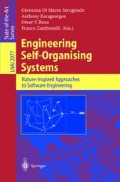Abstract
In order to cope with today’s dynamic environment, the described manufacturing control system is designed as a self-organising multi-agent system. The design of this novel system implements the PROSA reference architecture [1]. Coordination among agents is done indirectly through a pheromone-based dissipative field as is done by social insects in coordinating their behaviour. In this case, our agents act as social insects interpreting the pheromones put by the others in the environment. This control system is built from the basic elements of any manufacturing controller, namely products, resources and orders. However, the overall control system is constructed not only from those basic elements but also employing the appropriate interaction patterns among the agents who represent them. For coordination purposes, the agents send out a kind of mobile agents – artificial ants – to lay down information on the environment. In our case, where fulfilling the manufacturing orders is the main concern, there are at least 3 types of ant in this system: (1) feasibility ants – to propagate information concerning the feasible finishing routes; (2) exploring ants – to explore the feasible routes; and (3) intention ants – to propagate the route preferences. The overall mechanism enables the system to exhibit a self-organising behaviour.
Access this chapter
Tax calculation will be finalised at checkout
Purchases are for personal use only
Preview
Unable to display preview. Download preview PDF.
References
Van Brussel, H., Wyns, J., Valckenaers, P., Bongaerts, L., Peeters, P.: Reference architecture for holonic manufacturing systems: PROSA. Computers In Industry 37 (1998)
Haken, H.: Information and Self-Organization: A Macroscopic Approach to Complex Systems. Springer, Germany (1988)
ESOA WG - Mission Statement, http://cui.unige.ch/~dimarzo/esoawg/mission.doc
Crutchfield, J.P.: Is Anything Ever New? Considering Emergence. SFI Series in the Sciences ofComplexity XIX. Addison-Wesley, Reading (1994)
Heylighen, F.: Self-organization, Emergence and the Architecture of Complexity. In: Proceedings ofthe 1st European Conference on System Science, Paris (1989)
Goldstein, J.: Emergence as a Construct: History and Issues. Emergence 1(1) (1999)
Glansdorff, P., Prigogine, I.: Thermodynamic Theory of Structure, Stability and Fluctuations. Wiley, New York (1978)
Parunak, H.V.D., Sauter, J., Clark, S.: Toward the Specification and Design of Industrial Synthetic Ecosystems. In: Rao, A., Singh, M.P., Wooldridge, M.J. (eds.) ATAL 1997. LNCS, vol. 1365, Springer, Heidelberg (1998)
Jackson, M.: Software Requirements and Specifications. Addison-Wesley, Amsterdam (1995)
Theraulaz, G., Bonabeau, E.: A Brief History of Stigmergy. Artificial Life 5, 97–116 (1999)
Dorigo, M., Di Caro, G., Gambardella, L.M.: Ant Algorithms for Discrete Optimization. Artificial Life 5, 137–172 (1999)
Valckenaers, P., Kollingbaum, M., Van Brussel, H., Bochmann, O.: Short-term forecasting based on intentions in multi-agent control. In: Proceedings of the 2001 IEEE Systems, Man, and Cybernetics Conference, Tucson (2001)
Hadeli, V.P., Kollingbaum, M., Van Brussel, H.: Multi-Agent Coordination and Control Using Stigmergy. Accepted for publication in Journal Computers in Industry
Zamfirescu, C., Valckenaers, P., Van Brussel, H., Saint-Germain, B.: A Case Study for Modular Plant Architecture. In: Mařík, V., McFarlane, D.C., Valckenaers, P. (eds.) HoloMAS 2003. LNCS (LNAI), vol. 2744, pp. 268–279. Springer, Heidelberg (2003)
Heylighen, F.: The Science of Self-Organization and Adaptivity. The Encyclopedia of Life Support Systems (2002)
Author information
Authors and Affiliations
Editor information
Editors and Affiliations
Rights and permissions
Copyright information
© 2004 Springer-Verlag Berlin Heidelberg
About this paper
Cite this paper
Hadeli, K. et al. (2004). Self-Organising in Multi-agent Coordination and Control Using Stigmergy. In: Di Marzo Serugendo, G., Karageorgos, A., Rana, O.F., Zambonelli, F. (eds) Engineering Self-Organising Systems. ESOA 2003. Lecture Notes in Computer Science(), vol 2977. Springer, Berlin, Heidelberg. https://doi.org/10.1007/978-3-540-24701-2_8
Download citation
DOI: https://doi.org/10.1007/978-3-540-24701-2_8
Publisher Name: Springer, Berlin, Heidelberg
Print ISBN: 978-3-540-21201-0
Online ISBN: 978-3-540-24701-2
eBook Packages: Springer Book Archive

